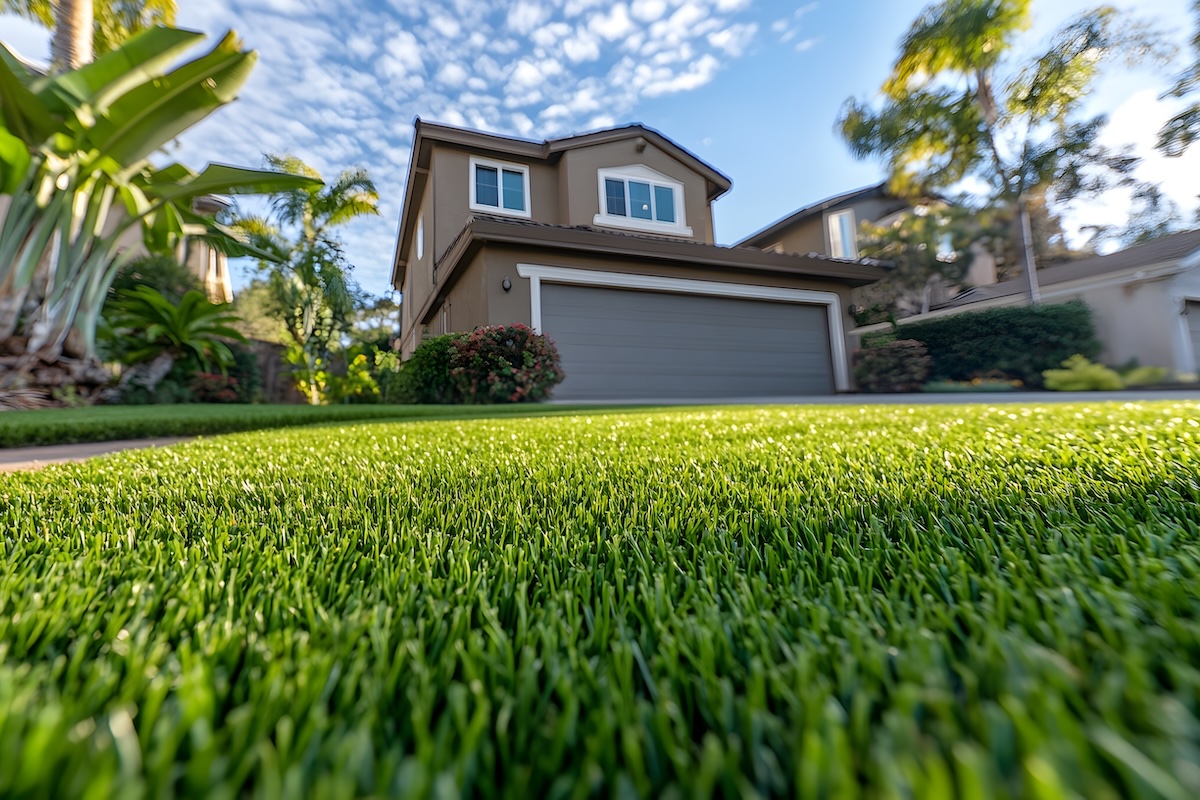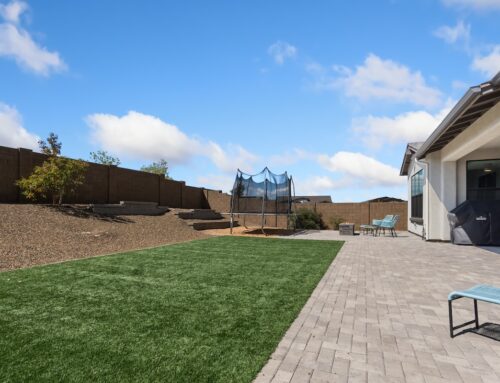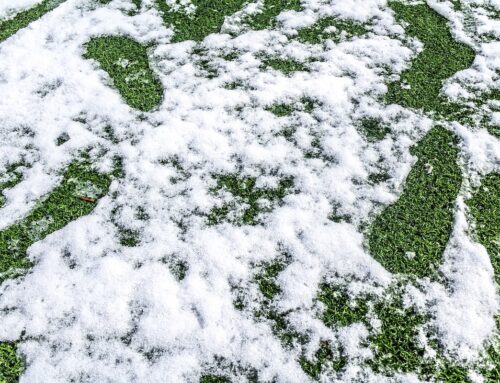Last Updated on July 19, 2025 by ReTurf
If you’ve ever spent a summer afternoon swatting at flies or spraying for ants, you’ve probably wondered—does artificial turf help or hurt when it comes to bugs? After all, one of the biggest perks of switching to synthetic grass is cutting down on yard maintenance. So, it’s only fair to ask whether turf keeps pests away or gives them a new place to hang out.
There’s a common, fuzzy assumption that plastic surfaces might attract bugs, especially flying ones, due to:
- Static electricity (which can attract dust)
- The idea that synthetic materials might “feel like” shelter or water to insects
- Confusion with patio lights or other surfaces that reflect UV and attract flying insects
But turf isn’t a light source. It’s not sticky or sweet. And there’s no scent, food, or water in the fibers the way there is in a natural sod and grass yard. The material doesn’t attract bugs—what’s around it might.
The short answer: Artificial turf generally repels bugs rather than attracts them—but the exact details depend on what kind of pest you’re talking about. Let’s break it down by type, so you know exactly what to expect.
Ants
Turf Can Disrupt Ant Nests
Ants love real grass for one reason: access. Soil, roots, organic debris—all of it gives them room to tunnel, build anthills and mounds, and expand their colonies. But artificial turf cuts off that access in a big way.
With turf, there’s no natural thatch layer or root system to hide in. It sits on a compacted base of crushed rock, sand, or a weed barrier, which doesn’t exactly scream “home sweet home” to an ant. In fact, most ant colonies will bypass turf altogether because they can’t easily build in or under it.

That said, if the turf was installed without a proper barrier layer or if there are edges where the base meets exposed soil, ants might still find a way in—just not through the turf itself. And if there’s food or spilled sugar from a backyard picnic, they’ll go wherever that is, turf or not.
Bottom line: Turf isn’t an ant magnet. It’s more likely to disrupt their usual nesting patterns, especially when professionally installed with a compacted, well-draining base.
Mosquitos
Standing Water is the Issue
Mosquitos aren’t attracted to grass—they’re attracted to water. They lay their eggs in standing pools, and that’s where turf can help make a noticeable difference.
Artificial turf is designed to drain fast. A properly installed system includes a base layer and sometimes even a perforated backing that moves water through the surface and down into the ground below. That means fewer puddles and less standing water, especially after rain or watering.
What turf doesn’t do is eliminate mosquitos entirely on its own. If you’ve got open containers, clogged gutters, or birdbaths holding stagnant water nearby, those will naturally still be prime breeding zones.
Bottom line: Turf repels mosquitos indirectly by reducing standing water, but it doesn’t repel them chemically. You’ll still need to manage nearby water sources.
Ticks
Ticks & Turf: What You Need to Know
Ticks prefer cool, shady environments with high grass and lots of leaf litter—places where they can perch and wait for a host to walk by. Natural lawns, especially overgrown ones or areas with brush, are ideal for ticks. Artificial turf? Well… not so much.

Synthetic grass is dry, and doesn’t offer the kind of cover ticks need. There’s no real leaf litter, no root system, and no thick vegetation to hide in. Thus, ticks are far less likely to thrive in turf-covered yards—especially in places that used to have dense vegetation, leaf litter, or natural grass.
Bottom line: Ticks tend to avoid or ignore artificial turf altogether. Replacing wooded or overgrown areas with artificial turf makes the environment much less suitable for ticks. If you’re trying to make your yard less inviting to them, turf is a smart move.
Flies
Not Drawn to the Grass Itself
Flies are opportunists. They’re after food, moisture, and waste—not grass. So, whether you have a real lawn or synthetic turf, flies will come around if there’s garbage, pet waste, or leftovers from the BBQ.
But artificial turf can help with control in two ways:
- Easier cleanup: Since there’s no soil to trap residue or food particles, spills and pet waste can be cleaned more thoroughly on turf.
- Better drainage: Less pooling moisture means fewer places for flies to breed.
Keep in mind that flies aren’t picky—they’ll land on a picnic table, patio furniture, or even your dog before they care about what kind of lawn you’ve got.
Bottom line: Turf doesn’t attract flies, and it may help keep them away by improving hygiene and water control.
Fleas
Less Habitat, Less Problem
Fleas are another pest that thrives in moist, shady environments—especially areas with tall grass or warm soil. That’s why pets who roll around in natural grass often bring fleas inside with them.
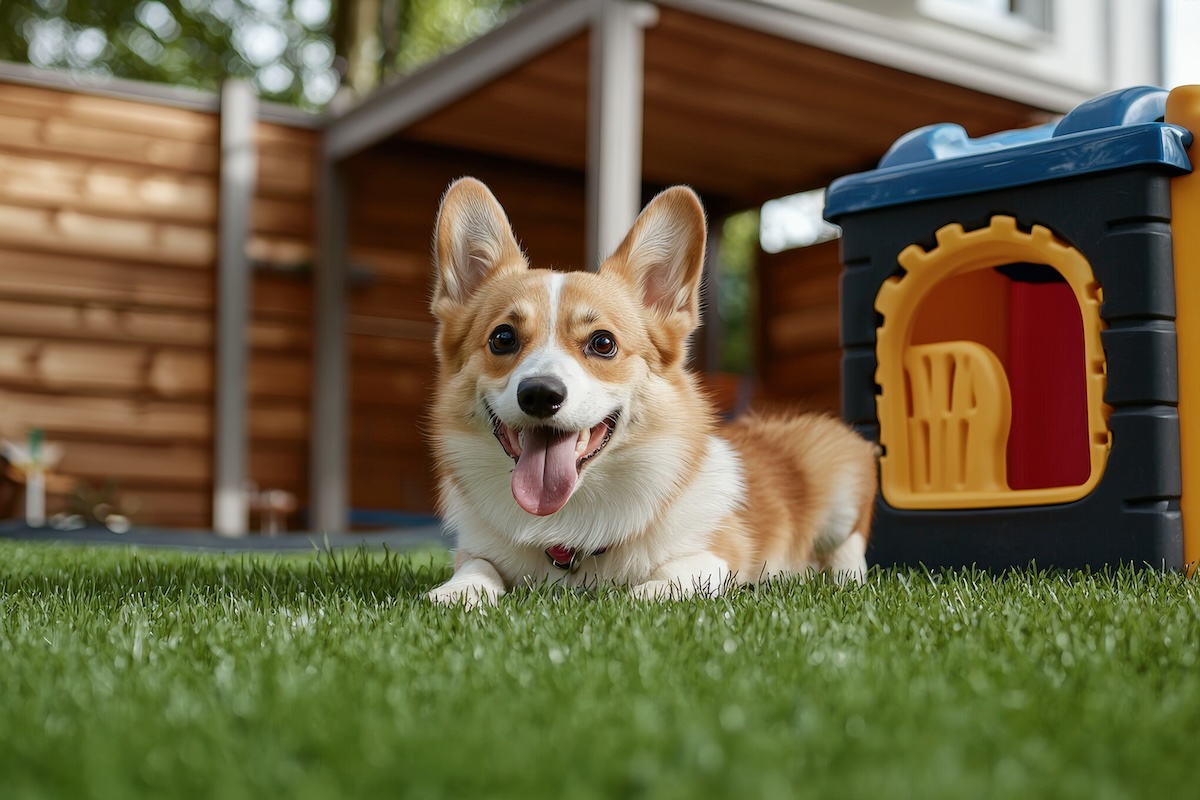
Artificial turf changes that. It doesn’t hold moisture the same way, and it lacks the organic debris and soil depth that fleas use to breed and develop. While fleas can still be brought into your yard by neighborhood animals, they generally won’t stick around long if there’s no soil to nest in.
That said, if you’ve got dogs or other pets, you’ll still need to manage flea control with vet-recommended treatments. But in terms of yard environment, turf makes life harder for fleas.
Bottom line: Fleas don’t thrive in turf the way they do in natural grass. It’s a less hospitable environment overall.
Spiders
Turf Doesn’t Offer Arachnids Much Shelter
Spiders don’t eat grass—but they do love insects, moisture, and dark, quiet places to hide. In natural grass, especially when it’s long or unkempt, spiders can find plenty of cover, along with a buffet of bugs to feed on.
Artificial turf simply doesn’t provide that kind of ecosystem. There’s no dense root mat for them to hide in, no decomposing matter, and fewer insects overall. Without tall blades and organic clutter to hide in, ground-based spiders don’t usually make turf their home.
Could one still wander across the lawn? Sure. (That’s what pesticide is for!) But they’re far more likely to set up shop under a nearby rock, shed, or woodpile than they are in the turf itself.
Now, web-building spiders are a bit different than ones that keep to the ground—they hang around where their webs can catch flying insects. You’re more likely to see them near bushes, fence posts, or porch lights than around the turf itself. However, even they tend to show up less in turf-heavy yards where there’s an overall lower insect population and less prey flying low to the ground.
Bottom line: Turf doesn’t attract spiders. If anything, it gives them fewer reasons to stick around.
Roaches
No Organic Buffet
Cockroaches are survivors. They like dark, damp, and dirty places—especially those with access to food scraps, decomposing matter, and places to burrow.
That’s why real grass, mulch beds, compost piles, and moist soil can all serve as hiding spots for roaches. But with artificial turf, there’s no soil, no mulch, and no rotting organic material. Just synthetic blades sitting on a compacted base. It’s not exactly a five-star roach hotel.
Of course, roaches can still be a problem near turf edges if the installation butts up against untreated areas, mulch beds, or trash bins. Good landscaping practices—like sealing gaps and keeping organic debris under control—will go a long way.
Bottom line: Turf repels roaches by removing their preferred food and shelter sources, but perimeter control is still important.
Bees and Wasps
Less Foraging, But Still Curious
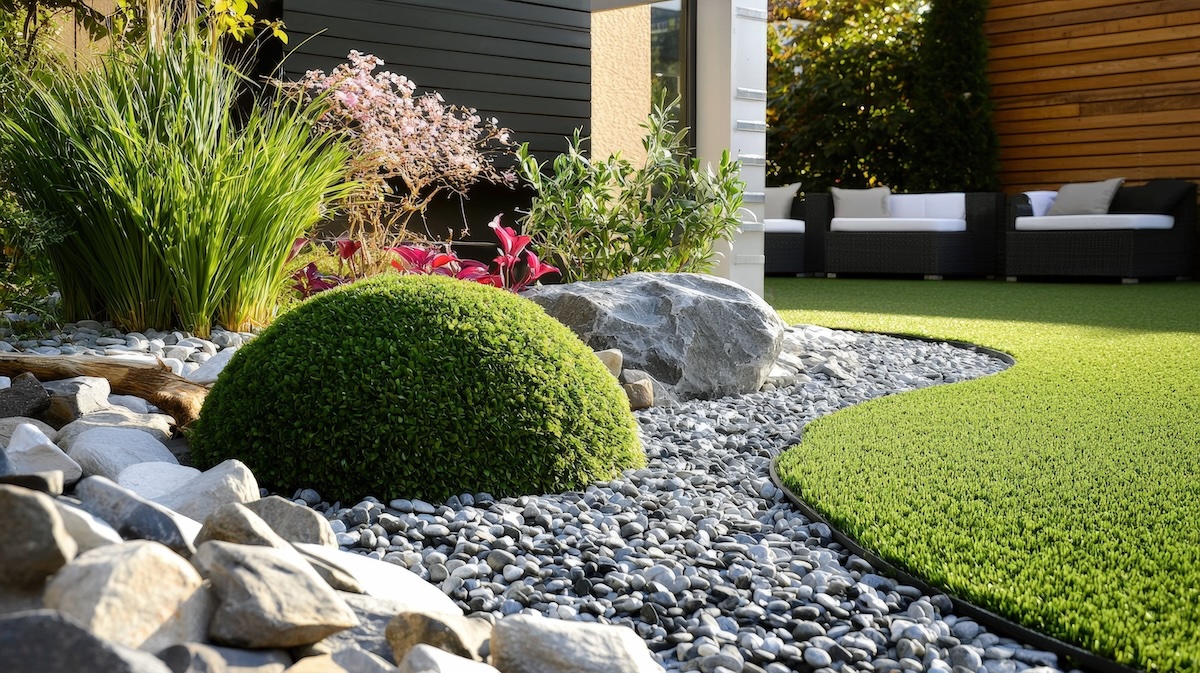
Bees and wasps don’t live in or feed off turf, but they can still buzz through the yard if you’ve got natural plants like flowers or clover (or sugary drinks!) nearby.
Natural grass sometimes plays host to flowering weeds like clover and dandelions, which attract pollinators. Turf doesn’t grow those, so it cuts off a major nectar source. That means you’ll likely see fewer bees nosing around the lawn itself.
Wasps are more opportunistic. They’ll hang around food scraps, sugary drinks, and even standing water. But like bees, they don’t care about the turf—just what’s happening nearby.
One exception: ground-dwelling bees and yellowjackets sometimes dig nests into bare patches of soil. However, artificial turf installation covers and compacts the ground, making it tough for these stinging insects to tunnel in.
Bottom line: Artificial turf doesn’t attract bees or wasps, and it may even reduce nesting activity. Still, keep food and drinks covered during outdoor meals if you want to avoid unwanted attention.
Gnats
No Soil, No Swarm
Gnats—especially fungus gnats and lawn gnats—aren’t after the grass itself. They’re drawn to soggy soil, decomposing roots, and the moist organic debris that collects in natural lawns. That’s why you sometimes see swarms of tiny flying bugs rise up when mowing or walking through wet grass.
Artificial turf doesn’t offer any of that. There’s no soil for fungus to grow in, no mulch for them to breed in, and no dead roots to support their life cycle. Plus, with fast-draining materials underneath, turf dries out before it can attract any major gnat activity.
If gnats are still hanging around your yard, it’s more likely they’re coming from nearby potted plants, compost piles, or damp mulch beds—not the turf.
Bottom line: Turf eliminates the conditions that attract gnats, helping keep those annoying clouds of bugs out of your yard.
Chiggers
Cut Off at the Source
Chiggers are tiny mite larvae that thrive in tall grass, dense vegetation, and damp, shaded areas. They’re nearly invisible, but their bites pack a punch—intense itching and red welts that can last for days.
In natural grass, especially if it’s not mowed regularly or if the turf borders brushy areas, chiggers can be a real problem. But artificial turf completely changes that equation.
Turf doesn’t have the thick undergrowth or shady humidity that chiggers love. It dries out quickly after rain, doesn’t trap heat or moisture the same way, and isn’t connected to the same kind of vegetation chain that supports chigger populations.
If your turf is installed with a weed barrier and borders clean, low-maintenance edging (like rock, concrete, or mulch), the odds of chiggers moving in are very low.
Bottom line: Turf repels chiggers naturally by removing the moist, brushy conditions they need to survive.
Grubs
Essentially a Non-Issue With Turf. Here’s Why:
Grubs are the larvae of beetles like June bugs and Japanese beetles, and they’re one of the biggest underground threats to natural lawns. They chew on grassroots just below the surface, killing patches of grass and drawing in animals like raccoons, moles, and skunks that dig up the lawn to eat them.
Artificial turf takes away everything grubs need: living grass, organic topsoil, and moisture-retaining thatch. During a proper installation, the real lawn is excavated, and a base of compacted stone or sand is laid down underneath the turf. There’s no organic matter left behind to feed on, and no reason for grubs to show up.
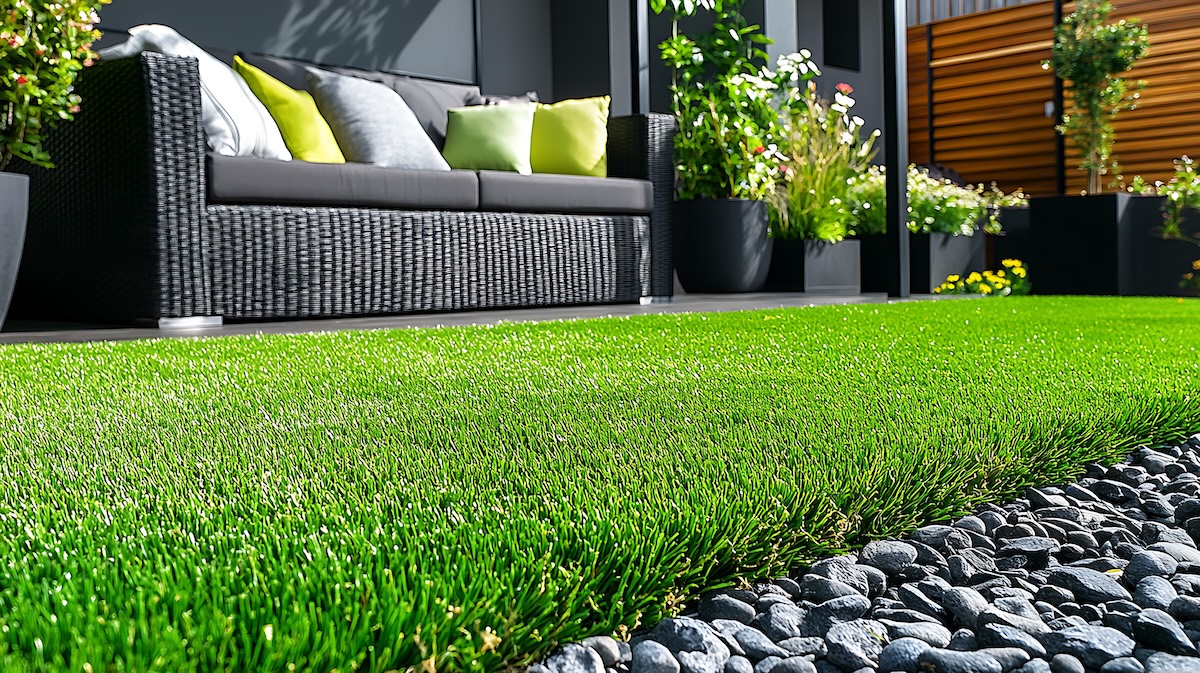
Some homeowners worry that grubs might “burrow up through” the turf somehow, but that’s not how it works. With no food source and no breathable soil, they won’t survive in a synthetic lawn environment.
Bottom line: Turf removes the food source and breeding ground grubs rely on. You won’t need grub treatments or have to worry about dead patches.
Turf as a Bug-Resistant Yard Solution
The Bottom Line
No insects are biologically drawn to artificial turf the way they are to real grass.
It doesn’t offer food, water, or shelter—the three things bugs are looking for. That means no bug is seeking out turf as a food source, nesting ground, or breeding site. If any bugs do show up near turf, they’re there for other reasons, not because of the turf itself.
When you break it down pest by pest, artificial turf consistently makes your yard less appealing to bugs. It’s not about chemical repellents or insecticides—it’s about removing the things pests need to survive: moisture, food, organic matter, and cover.
Here’s a quick summary:
Bug-by-Bug: How Artificial Turf Affects Common Lawn Pests
| Pest | Attracted to Turf? | Why or Why Not |
|---|---|---|
| Ants | No | Turf blocks soil access and doesn’t provide organic material for nesting |
| Mosquitos | No | Turf drains fast and doesn’t trap standing water |
| Ticks | No | No tall grass, moisture, or shaded cover—turf is inhospitable to them |
| Flies | No | Fewer breeding sites; easier cleanup reduces attractants |
| Fleas | No | No soil or thatch for larvae to develop in |
| Spiders | No | Fewer insects and hiding spots make turf less appealing |
| Roaches | No | Turf removes soil, cover, and organic food sources |
| Bees/Wasps | No | No flowers or nesting sites, but food and drinks nearby can still attract them |
| Grubs | No | Turf removes their food source (grass roots) and the soil they need to develop |
| Chiggers | No | Dry, open turf lacks the brushy, moist cover they thrive in |
| Gnats | No | Turf lacks the damp soil and decomposing matter they need for breeding |
So, if you’re looking for a low-maintenance yard that’s easier on both your back and your bug spray budget, turf can be a solid investment. It doesn’t make your yard 100% bug-proof, but it can tilt the odds largely in your favor—especially if it’s installed correctly and kept clean.

